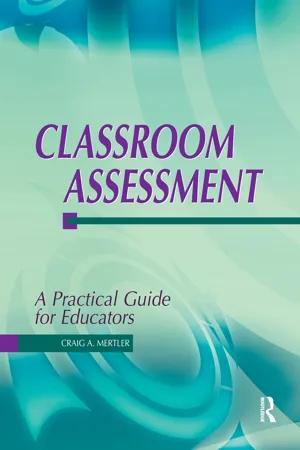
Classroom Assessment
A Practical Guide for Educators
Dr Craig Mertler
- 338 pages
- English
- ePUB (mobile friendly)
- Available on iOS & Android
Classroom Assessment
A Practical Guide for Educators
Dr Craig Mertler
About This Book
• Provides detailed information on
· the functions of assessment;
· how to construct, administer, and interpret the results of teacher-developed assessment techniques; and
· how to interpret the results of externally developed instruments such as standardized tests.
• Both traditional and newer, alternative assessment techniques are covered.
• Advantages and disadvantages of each assessment technique are discussed.
• A companion website helps both instructors and students obtain additional information on topics of special interest to them.
• Numerous examples of the principles and procedures make it easy for students to understand the material.
• The highly practical nature of this book stems from the focus on how assessment intertwines with other everyday activities in classrooms.
• Measurement theory and computational procedures that are unlikely to be used by classroom teachers are de-emphasized, producing a textbook that provides comprehensive coverage without being unnecessarily technical.
Frequently asked questions
Information
Table of contents
- Cover
- Title
- Copyright
- Contents
- Detailed Chapter Contents
- Preface
- Acknowledgments
- Dedication
- PART I: INTRODUCTION TO CLASSROOM ASSESSMENT
- PART II: ALTERNATIVE ASSESSMENT TECHNIQUES
- PART III: TRADITIONAL ASSESSMENT TECHNIQUES
- PART IV: ADDITIONAL ASSESSMENT ISSUES
- Appendix A: The Standards for Teacher Competence in the Educational Assessment of Students
- Appendix B: The Code of Fair Testing Practices in Education
- Appendix C: A Guide to Descriptive Statistics
- Classroom Assessment Glossary
- References
- Subject Index